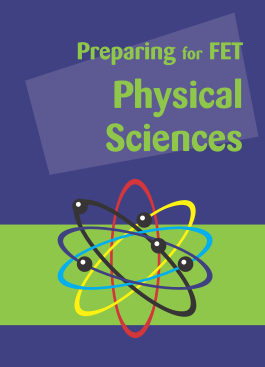
Preparing for FET Physical Sciences
Preparing for FET Physical Sciences is a course book which has been written for learners and teachers who want to:
- revise and consolidate key Physical Science and Chemistry skills in preparation for the end-of year Grade 9 General Science/ Natural Science exams;
- develop, revise and consolidate the key Physical Science and Chemistry skills they will need to succeed in the Physical Sciences in senior secondary grades (FET Grades 10, 11 and 12).
Preparing for FET Physical Sciences
- is diagnostic, remedial and reinforcing
- focusses on skills that are needed to carry out scientific calculations and experiments, and explanations of key scientific concepts.
View a full table of contents in PDF form
Each chapter in the book consists of:
- An introductory section of definitions;
- a diagnostic test to help learners to assess knowledge and skills that require improvement;
- relevant background information to assist in overcoming any shortcomings identified through the diagnostic testing;
- step-by-step explanations of key skills to consolidate learners' knowledge and understanding, plus worked examples of skills application; and
- practice questions to enable learners to asses progress in their skills development.
Preparing for FET Physical Sciences contains all the support that learners need to move confidently from General Science into the Physical Sciences.
Preparing for FET Physical Sciences focuses on the development and improvement of the following key skills and concepts:
- Observation and measurement
- How to distinguish between "quantitative" and "qualitative";
- Base units and derived units;
- How to convert from one unit to another.
- Maths in Physical Sciences
- Understanding formulae and their symbols;
- How to change the subject of formulae;
- How to substitute into formulae.
- Data handling
- How to record (ways in which to represent) data, e.g. graphs;
- How to distinguish between dependent and independent variables;
- How to interpret data, once it has been recorded.
- Kinetic theory, elements and compounds
- Essential concepts dealt with include: change of state (water melting, boiling, freezing, etc.);
- Distinguishing between elements, mixtures and compounds.
- Writing chemical formulae
- Naming of covalent and ionic compounds, including ionic compounds with polyatomic ions;
- Writing of chemical formulae for covalent and ionic compounds, including ionic compounds with polyatomic ions.
- Writing chemical equations
- Writing chemical equations in words, and in symbols and formulae;
- Balancing of formula equations.
- Electrostatics
- Current electricity
- How to understand electric circuits and diagrams, and series and parallel connections;
- How to calculate potential difference, current strength and resistance.
- Mechanics
- A brief introduction to this topic is offered, so as to provide a sound foundation for future study, dealing as it does with concepts such as velocity, average speed, time elapsed, etc.
For further information on Preparing for FET Physical Sciences or to order it, contact Publishing Resource Solutions.
